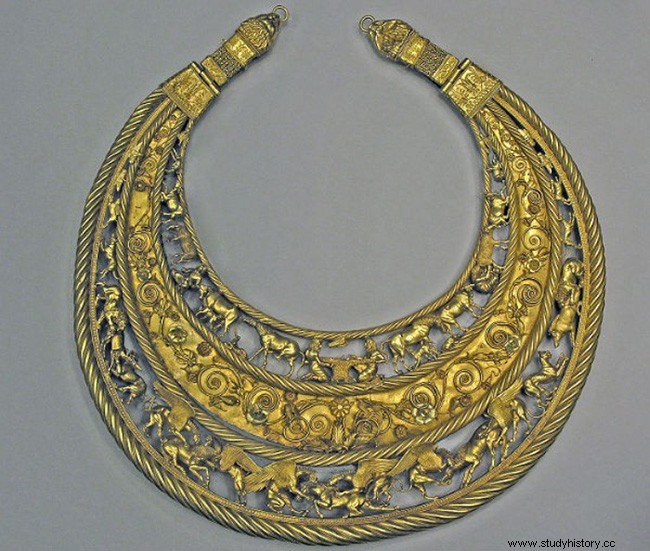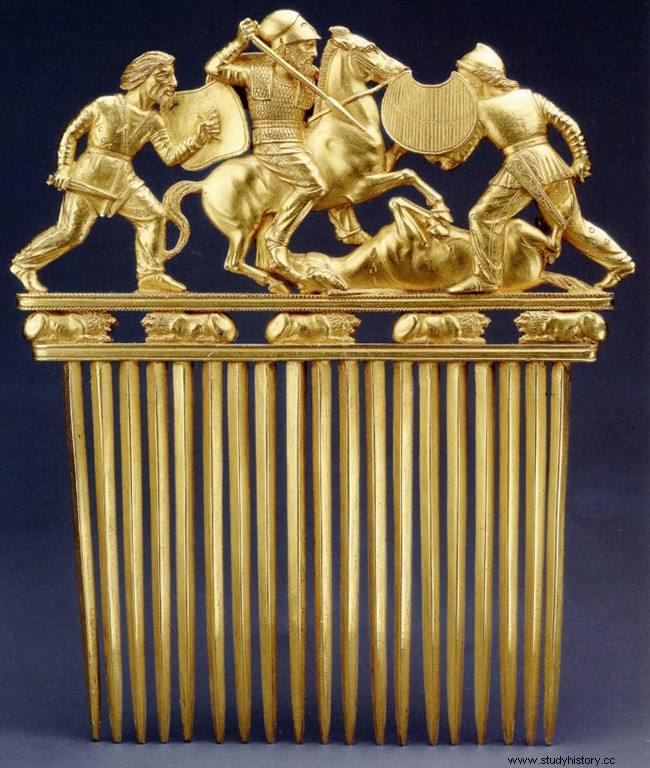
We moved to the Pontic steppes, located between the Black and Caspian seas to see the remains of the ancient Scythian culture. Its origin, like most of these nomadic peoples, is really uncertain, some sources point to the 10th century BC. C., when they arrive in that area fleeing after some defeat before the armies of the Chinese emperors. Although the oldest archaeological remains assigned to this culture are usually circumscribed around the 7th century BC. C., some classic writers already echo them, at that time or even before. For example, some words that have been attributed to the Greek poet Homer:
“they are demon-possessed men, cannibal lycanthropes, head hunters who used the skulls to drink from.”
Certainly the Greeks were among the first peoples to meet them on their sea voyages through the Black Sea. Although this last description may seem a bit pejorative, it is not so negligible, since according to some sources they drank the blood of their victims and after skinning them, they decorated their warrior garments with the skins of their rivals.

Idyllic image of the Pontic steppes.
Nomads of the steppes.
Later, this people of transhumant warriors, shepherds of the steppes, who dedicated themselves to traveling thousands of kilometers in search of the best pastures, (their remains have been found in Hungary, Poland, and even near present-day Berlin), are masterfully described by the father of history studies, Herodotus. He knew them first hand, since he arrived in Olbia, a small Greek colony located at the mouth of the Dnieper River during the mandate of Pericles (469-429 BC). According to him, from the gates of the city the view was lost in the steppes inhabited by the Scythians, hence its inhabitants knew them well, since at that time it had been more than a century since Greeks and Scythians exchanged products and experiences. .

Detail of the pectoral of Tolstaya, with a young man who has just milked a sheep.
The Scythians carried their house on their backs, sometimes in large tents with even three rooms, others in four-wheeled wagons landed directly by oxen. To protect their community they became excellent warriors. Masterful was his way of using the small bow to be able to execute the shots as they rode. They completed their attire with a sword, spear, dagger and a large leather bag with a capacity for more than 50 arrows. It seems that they were pioneers in protection measures, since archaeologically they remind us of high medieval warriors with their iron or bronze mail.
But what is inseparable is the Scythian people and the horses. Both men and women rode, and possibly learned to ride and walk at the same time. As was becoming usual among the peoples of the steppes, it was their means of locomotion, their main weapon of war, and ultimately their faithful companion. But they also ate their meat, presumably from the older and less able-to-ride individuals. The mares were milked, cheeses and alcoholic beverages were made from their milk. In addition, they became the most faithful companions of the Scythian nobles and kings in the transfer to the afterlife, dozens of horses sacrificed to accompany them have been located in various tombs.
The Scythians in history.
They not only maintained commercial contacts with the surrounding towns. The Scythians became looters of the peoples settled both in Eastern Europe and those located north of the fertile crescent. There are several times that their participation in wars between ancient states has been recorded. Without going any further, they possibly participated as a mercenary force, along with Babylonians and Medes, in the destruction of the all-powerful Assyrian capital of Nineveh.

Locating the Scythians on a map is complicated, but this would be an approximation to reality. Some of their plundering routes are even seen in the Fertile Crescent, or Egypt.
One of his most prominent conflicts was against the Persian king Darius I (521-485 BC), apparently this Persian king tried to conquer the territory of the Scythians. Despite the fact that the latter suffered heavy casualties, they were unable to subjugate them. Due to the success of the resistance against the Persians, the Scythian people entered their time of greatest political splendor. From said VI century a. C., begins a certain sedentarization of these nomads of the steppes. The chosen place was the lower course of the Dnieper River, since they traded openly with the Greek colonies on the shores of the Black Sea. Noteworthy is the Belsk site, surrounded by about 33 km of walls. Outside, the impressive kurgans that served as the home of the late Scythian kings have been located.
Two centuries after the war against the Persians, and due in part to the fact that sedentarization made the Scythian community grow in importance, new enemies ended up emerging. The worst was the Macedonian Philip II who inflicted a severe defeat on them in 339 BC. C., from which they practically did not recover. The Scythian culture disappeared in the same way that it arrived at least eight centuries before, neither archeology nor the interpretation of classical sources have been able to decipher the reasons for this disappearance.
The rich Scythian tombs.
To the south of the commented site of Belsk and elevated on a hill, about twenty kurgans have been located, the name by which the tombs of the Scythians are known. Kings and high aristocracy were buried in these large circular mounds that reached 100 m in diameter.

Archaeological zone of the Kurgans.
According to Herodotus once again, the religion of the Scythians is behind this form of burial. They did not erect large temples or large statues, at most small high altars, where animals were sacrificed in honor of the Scythian gods, especially Ares, the king of war.
His belief in the "beyond" and the prolongation of earthly life in a kind of immortality, was the origin of these sumptuous burials. When the king died, his subjects dug a large square grave. After going through the different towns transporting the remains of the deceased, he was deposited in the center of the great grave on a bed of leaves and herbs. Then a few servants were killed, including a cook and a concubine, as well as a few horses. Later all of them were deposited around the king, to accompany him in the life that he was to come. Not forgetting lastly his belongings, in the form of luxurious tableware or sumptuous jewelry.
These jewels have been used by archaeologists to interpret the way of life of the Scythians. There would be innumerable pieces that we could name, but we are going to keep these two:
Tolstaya Magilla's breastplate . It is a spectacular gold necklace that weighs 1150 grams, in the shape of a half moon. Separated by strings, different scenes from the life of the Scythians are depicted. Especially the importance of hunting and the symbiosis of this town with nature is denoted; leaves, birds, boars, deer or lions. It is also important to highlight the relationship of the Scythians with livestock, their main source of life, in scenes with men making skins or children milking a sheep.

Tolstaya Magilla pectoral.
Soloja's comb . This spectacular 294 gr. comb, which is currently exhibited in the Hermitage Museum in Saint Petersburg, is one of the most famous pieces of Scythian culture. The scene it represents is the fight between three Scythian warriors, supported by lions. According to experts, it is one of the best examples of the cultural encounter between Scythians and Greeks, as it is introduced into the typical Scythian scene, helmets or armor of Greek clothing.

Soloja Comb
These, as noted, are just two examples of the spectacular jewelry that came out of the Scythian workshops. Undoubtedly the "tip of the iceberg" of the wealth that the Scythian kings and aristocrats hoarded after their contact with the Greeks. There is evidence of the great looting that these Scythian tombs scattered around the Black Sea have suffered for 2000 years.
The Scythian culture disappeared between the III-II centuries B.C. The causes, as already mentioned, remain a mystery. To this day, the Scythian heritage among the peoples settled in the vicinity of the Black Sea is still being studied. The investigations refer us to the current people of the Ossetians, as their most plausible heirs. In ancient times, the Sarmatians who fought against Rome, possibly after conquering the Scythians, or the Alans who crossed the Germanic limes at the beginning of the 5th century with the barbarian peoples, carried both Scythian genes.
More info:
Prehistory II, metallurgical societies, Ana Fernández Vega (coor), Ed. Uned, 2011.
The Scythian nomads and goldsmiths of the steppes, Unesco publication, 1976.
arrecaballo.es
